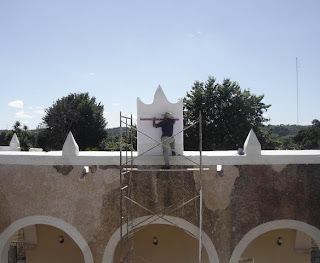Gnomon CURIOUS CASE ... COLONIAL? Solar Watches
The Convent of the Assumption of Muna, Yucatan, dating from the late seventeenth century and its cloister presents a set of four solar quadrants oriented to the four cardinal points. Its construction date is unknown to us, but we assume is contemporary to the time of erection of the convent.
The reason for this note, in addition to highlighting the existence of these plots (of which only one of them "keep" the gnomon) is its peculiar way to mark paths and nomeclatura time since ... none of them is right! We know that in the case of historical quadrants may be slight (or large) discrepancies in the schedule drawn mainly the calculation of the decline of the wall, but this case ... is really special.

1: Overview of the Cloister of the Convent of the Assumption of Muna, Yucatan, with its four sundials.

2: Quadrants to the East and South. Apparently, the paths are correct ...
 Fig. 3. Direct Midi Clock. The nomeclatura time starts at 6 (VI) hours in the left quadrant, up to 12 (XII) hours in the crystal. But when it is not for one in the afternoon ... but the 6 (VI) hours! This is because inexplicably begin numbering the evening hours from 1 to 6, but starting from the right side of the quadrant to the meridian, ie in the opposite direction (?). In this clock, therefore, the decline is marked at one o'clock.
Fig. 3. Direct Midi Clock. The nomeclatura time starts at 6 (VI) hours in the left quadrant, up to 12 (XII) hours in the crystal. But when it is not for one in the afternoon ... but the 6 (VI) hours! This is because inexplicably begin numbering the evening hours from 1 to 6, but starting from the right side of the quadrant to the meridian, ie in the opposite direction (?). In this clock, therefore, the decline is marked at one o'clock.
Special mention should be made of the poor design of the gnomon, which is not in limbo the angle corresponding to the colatitude of the place (Muna, Yucatán: 20 ° 29'6 .03 "N 89 ° 42'46 .49" W) but is a simple rod perpendicularly embedded "in the pole" of radiation.

Fig. 4. Direct Watch Levante. Although this type of watches can only make ortho-hour at noon, here the numbering of the time 1 (I) hours at the top to the 6 (VI) hours in the bottom ... and turn around in ascending order until the 12 (XII) hours back to the top of the dial!
also paths schedules, especially those must correspond to the sixth and seventh hours have a similar separation between them.
Direct Watch West has a very similar arrangement with its corresponding towards the east, but the North has direct clock schedules identical to the direct routes to Noon. We
to conjecture:
1 st: The orientation of the four walls is correct, I have not had the opportunity to make exploratory coves sgraffito stucco that could reveal any previous intervention stage, since it is not logical sundials an implementation of well-targeted but poorly targeted.
2: The quality of these graffiti bill is very poor, which suggests that it is a further intervention by a hand made unfit for gnomonic issues.
3: A third conjecture can guess that actually are original paths (remember the ordinances binding on all the monasteries of the Seraphic Order to have sundials in their monasteries) but had to be done "to get by" possibly using or copying similar clocks correctly traced as in the case of the Convent of Mama.
The most likely case of an attempt to recover relatively recently. In fact the original quadrants possibly consisted of stone slabs, which are being lost.
be a restoration of this set of squares, I think we should replace the stone slabs with correct paths (without corrections for length or time zone, to respect the spirit of the time) and before deleting the existing tracks, record carefully the curious case of "gnomonic colonial" present in one of the buildings that make up our architectural heritage.
 Fig. 1. Stroke of watches to the west and north. Simple paths are marked local solar time.
Fig. 1. Stroke of watches to the west and north. Simple paths are marked local solar time. 






 1: Overview of the Cloister of the Convent of the Assumption of Muna, Yucatan, with its four sundials.
1: Overview of the Cloister of the Convent of the Assumption of Muna, Yucatan, with its four sundials. 
 Fig. 3. Direct Midi Clock. The nomeclatura time starts at 6 (VI) hours in the left quadrant, up to 12 (XII) hours in the crystal. But when it is not for one in the afternoon ... but the 6 (VI) hours! This is because inexplicably begin numbering the evening hours from 1 to 6, but starting from the right side of the quadrant to the meridian, ie in the opposite direction (?). In this clock, therefore, the decline is marked at one o'clock.
Fig. 3. Direct Midi Clock. The nomeclatura time starts at 6 (VI) hours in the left quadrant, up to 12 (XII) hours in the crystal. But when it is not for one in the afternoon ... but the 6 (VI) hours! This is because inexplicably begin numbering the evening hours from 1 to 6, but starting from the right side of the quadrant to the meridian, ie in the opposite direction (?). In this clock, therefore, the decline is marked at one o'clock. 